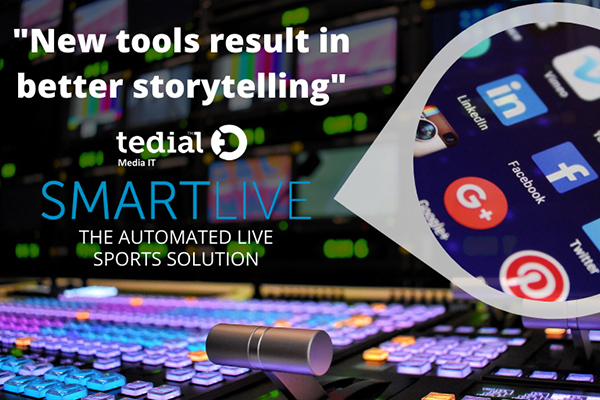These features and upgrades promise to offer broadcasters the edge they need to return to live programming and remote operations.
MAM technology solutions specialist Tedial has announced a number of new features for SmartLive, its automated live sports production solution; new functionalities to its Hybrid Cloud architecture; and new multiple deployment option features to its Hyper IMF MAM solution.
These features and upgrades promise to offer broadcasters the edge they need to return to live programming and remote operations.
Broadcasters can deliver improved and vivid graphics due to a new integration between SmartLive and Singular.live’s cloud-based technology for live graphic overlays. Graphics can be inserted into the SmartLive auto-generated EDL, reviewed in the player and then burned in when the EDL is flattened. This development gives broadcasters the capability to enhance storytelling by layering graphics on top of highlights.
In addition, SmartLive can now create transitions between EDL segments, such as fade in/fade out, adding a dynamic element to highlights. Providing an additional advantage for remote production Tedial’s player allows users to review content in different low-res quality with an automatic adaptive bit rate depending on the quality of the connection.
SmartLive is also now connected to a video AI engine which aims to detect replays into the video live stream or file to provide even more advanced storytelling, making highlights more dynamic.
Utilising AI tools, SmartLive leverages its metadata engine to automate clip creation to distribution. It also automates the event metadata ingest process; provides a production environment for the production team; provides multiple, instantaneous live searches to bring historical media and informational archives to live events.
It also automatically generates highlights, delivering them to digital platforms and social networks as well as traditional broadcast distribution channels as it’s directly connected to the production environment.
To maximise Hybrid Cloud capabilities, users need a dynamic content management solution that transparently manages various tiers across departments, locations or in the cloud. This includes on-premise live storage, nearline storage, deep archive tape libraries or public cloud storage such as AWS S3, AWS S3 Glacier Deep Archive or Microsoft Azure Blob Storage.
Tedial’s Evolution MAM is built with aSTORM, a dynamic content management solution that provides the ‘link’ between various storage and hosting scenarios. Using logical storage groups and rules defined within each group, the technology seamlessly moves, backs-up and restores content when and where required.
The cloud can also be used to host AI processes. Although operational workflows can be deployed on-premises or in the cloud, non-critical workflows such as automating metadata tagging with AI would typically be deployed in the cloud, while critical workflows would be deployed on-premises.
Tedial’s Hyper IMF is an end-to-end IMF workflow that supports IMF formats for ingesting, archive and delivery. Hyper IMF adds value to customers with new features including component-based assets with multi-resolution MPEG-Dash streaming and end-to-end IMF workflows with third-party systems integrations.
Deployment options include on local premises, in a public or private cloud with native S3 management, or in a hybrid cloud where heavy media manipulation can be completed on-premises and the distribution and activities that require external access can be carried out in the cloud.
The IMF automation deployments hope to support end-to-end workflows from the ingest of packages to the generation of new versions or the creation of new packages on-the-fly automatically, without human intervention.
Using Hyper IMF, media companies can achieve measurable efficiency, cost savings and the capability to profitably expand capacity and operations globally.
Commenting on the upgrades, Emilio L Zapata, CEO, Tedial said: “There are lessons to be learned from living through a pandemic that quarantined most of the world’s population, and for most this has been an eye-opener. Going forward, on-site footprints will be dramatically reduced. Remote operations talked about for years but not globally implemented, have been catapulted to the forefront of technology as a result of social distancing with both talent and tech working from home. Our sophisticated SmartLive and Hybrid Cloud technologies will assist media companies with these changes and help them to adapt as the industry moves forward.”

















































































